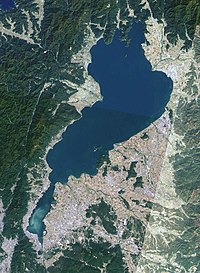بحيرة بيوا

| سميت باسم |
|---|
| الإحداثيات | |
|---|---|
| التقسيم الإداري | |
| دول الحوض |
| النوع | |
|---|---|
| مصب الأنهار |
Anegawa River (en) |
| منبع الأنهار | |
| مدة مكوث المياه |
| المساحة | |
|---|---|
| الطول | |
| عمق | |
| حجم المياه | |
| ارتفاع السطح | |
| طول الشاطئ |

بحيرة بيوا (باليابانية: 琵琶湖 بيوا-كو) هي أكبر بحيرة مياه عذبة في اليابان، تقع في محافظة شيغا.[1][2][3] بسبب قرب موقع بحيرة بيوا من كيوتو العاصمة القديمة لليابان، فإنها غالبا ما تظهر في الأعمال الأدبية اليابانية مثل الشعر.
تبلغ مساحة البحيرة حوالي 670 كم مربع، وتصب فيها بعض الأنهار الصغيرة ويحيط بها بعض الجبال منخفضة الارتفاع.
التسمية
[عدل]يعتقد بأن تسمية «بيوا» تعود إلى فترة إيدو. بينما كان يشار إلى البحيرة فيما سبق بتسميات عدة منها «أوا أومي» (淡海، بحر المياه العذبة) و«تشيكاتسو أوا أومي» (近淡海، بحر المياه العذبة بالقرب من العاصمة) والذي يعتقد بأنه أصل تسمية مقاطعة «أومي» الاسم السابق لمحافظة شيغا.
اقرأ أيضا
[عدل]- قناة بحيرة بيوا
- ميو بيواكو كوساتسو، نادي كرة قدم على ضفاف البحيرة
مراجع
[عدل]- ^ "Biwa, Lake". Academic Dictionaries and Encyclopedias. مؤرشف من الأصل في 2017-06-30.
- ^ Phylogeny and historical demography of endemic fishes in Lake Biwa: the ancient lake as a promoter of evolution and diversification of freshwater fishes in western Japan. Ecology and Evolution 6(8): 2601–2623. نسخة محفوظة 08 يونيو 2017 على موقع واي باك مشين.
- ^ Habu، Junko؛ Matsui، Akira؛ Yamamoto، Naoto؛ Kanno، Tomonori (2011). "Shell midden archaeology in Japan: Aquatic food acquisition and long-term change in the Jomon culture" (PDF). Quaternary International. ج. 239 ع. 1–2: 19–27. DOI:10.1016/j.quaint.2011.03.014. ISSN:1040-6182. مؤرشف من الأصل في 2017-08-10.
| في كومنز صور وملفات عن: بحيرة بيوا |
Text is available under the CC BY-SA 4.0 license; additional terms may apply.
Images, videos and audio are available under their respective licenses.

